Improvement of Air Pollution in China Inferred from Changes between Satellite-Based and Measured Surface Solar Radiation
Abstract
:1. Introduction
2. Materials and Methods
2.1. Data
2.1.1. The CLARA-A2 SSR Dataset
2.1.2. The CMA SSR Dataset
2.1.3. Cloud and Aerosol-related Information
2.2. Methods
2.2.1. Calculation of SSR Trends
2.2.2. Investigation of Aerosol Effects
3. Results and Discussion
3.1. Transition in the Annual SSR Bias Series since 2008
3.2. Analysis on Seasonal and Regional Scales
3.3. A Case Study of Beijing
4. Conclusions and Outlook
Author Contributions
Funding
Acknowledgments
Conflicts of Interest
References
- Wang, S.; Zhao, B.; Cai, S.; Klimont, Z.; Nielsen, C.; Morikawa, T.; Woo, J.; Kim, Y.; Fu, X.; Xu, J. Emission trends and mitigation options for air pollutants in east asia. Atmos. Chem. Phys. 2014, 14, 6571–6603. [Google Scholar] [CrossRef] [Green Version]
- Cofala, J.; Borken-Kleefeld, J.; Heyes, C.; Klimont, Z.; Rafaj, P.; Sander, R.; Schöpp, W.; Amann, M. Emissions of Air Pollutants for the World Energy Outlook 2011 Energy Scenarios; International Energy Agency: Paris, France, 2011. [Google Scholar]
- Zhang, Q.; Jiang, X.; Tong, D.; Davis, S.J.; Zhao, H.; Geng, G.; Feng, T.; Zheng, B.; Lu, Z.; Streets, D.G.; et al. Transboundary health impacts of transported global air pollution and international trade. Nature 2017, 543, 705–709. [Google Scholar] [CrossRef] [PubMed] [Green Version]
- Verstraeten, W.W.; Neu, J.L.; Williams, J.E.; Bowman, K.W.; Worden, J.R.; Boersma, K.F. Rapid increases in tropospheric ozone production and export from china. Nat. Geosci. 2015, 8, 690–695. [Google Scholar] [CrossRef]
- Wang, Y.; Wild, M.; Sanchezlorenzo, A.; Manara, V. Urbanization effect on trends in sunshine duration in china. Ann. Geophys. 2017, 35, 839–851. [Google Scholar] [CrossRef] [Green Version]
- Zhang, H.; Wang, S.; Hao, J.; Wang, X.; Wang, S.; Chai, F.; Li, M. Air pollution and control action in beijing. J. Clean. Prod. 2016, 112, 1519–1527. [Google Scholar] [CrossRef]
- Jin, Y.; Andersson, H.; Zhang, S. Air pollution control policies in china: A retrospective and prospects. Int. J. Environ. Res. Public Health 2016, 13, 1219. [Google Scholar] [CrossRef] [Green Version]
- Wild, M. Global dimming and brightening: A review. J. Geophys. Res. Atmos. 2009, 114. [Google Scholar] [CrossRef] [Green Version]
- Ramanathan, V.; Crutzen, P.J.; Kiehl, J.T.; Rosenfeld, D. Atmosphere—Aerosols, climate, and the hydrological cycle. Science 2001, 294, 2119–2124. [Google Scholar] [CrossRef] [Green Version]
- Charlson, R.J.; Schwartz, S.E.; Hales, J.M.; Cess, R.D.; Coakley, J.A.; Hansen, J.E.; Hofmann, D.J. Climate forcing by anthroogenic aerosols. Science 1992, 255, 423–430. [Google Scholar] [CrossRef]
- Stanhill, G.; Cohen, S. Global dimming: A review of the evidence for a widespread and significant reduction in global radiation with discussion of its probable causes and possible agricultural consequences. Agric. For. Meteorol. 2001, 107, 255–278. [Google Scholar] [CrossRef]
- Wild, M. Enlightening global dimming and brightening. Bull. Am. Meteorol. Soc. 2012, 93, 27–37. [Google Scholar] [CrossRef]
- Ohmura, A. Observed decadal variations in surface solar radiation and their causes. J. Geophys. Res. 2009, 114. [Google Scholar] [CrossRef] [Green Version]
- Kambezidis, H.D.; Kaskaoutis, D.G.; Kharol, S.K.; Moorthy, K.K.; Satheesh, S.K.; Kalapureddy, M.C.R.; Badarinath, K.V.S.; Sharma, A.R.; Wild, M. Multi-decadal variation of the net downward shortwave radiation over south asia: The solar dimming effect. Atmos. Environ. 2012, 50, 360–372. [Google Scholar] [CrossRef]
- Wild, M.; Gilgen, H.; Roesch, A.; Ohmura, A.; Long, C.N.; Dutton, E.G.; Forgan, B.; Kallis, A.; Russak, V.; Tsvetkov, A. From dimming to brightening: Decadal changes in solar radiation at earth’s surface. Science 2005, 308, 847–850. [Google Scholar] [CrossRef] [PubMed] [Green Version]
- Kambezidis, H.D.; Kaskaoutis, D.G.; Kalliampakos, G.K.; Rashki, A.; Wild, M. The solar dimming/brightening effect over the mediterranean basin in the period 1979–2012. J. Atmos. Sol. Terr. Phys. 2016, 150–151, 31–46. [Google Scholar] [CrossRef]
- Wang, Y.; Wild, M. A new look at solar dimming and brightening in china. Geophys. Res. Lett. 2016, 43, 11777–11785. [Google Scholar] [CrossRef]
- Yang, S.; Wang, X.L.; Wild, M. Homogenization and trend analysis of the 1958–2016 in situ surface solar radiation records in china. J. Clim. 2018, 31, 4529–4541. [Google Scholar] [CrossRef]
- Pfeifroth, U.; Sanchez-Lorenzo, A.; Manara, V.; Trentmann, J.; Hollmann, R. Trends and variability of surface solar radiation in europe based on surface- and satellite-based data records. J. Geophys. Res. Atmos. 2018, 123, 1735–1754. [Google Scholar] [CrossRef]
- Sanchez-Lorenzo, A.; Wild, M.; Brunetti, M.; Guijarro, J.A.; Hakuba, M.Z.; Calbó, J.; Mystakidis, S.; Bartok, B. Reassessment and update of long-term trends in downward surface shortwave radiation over europe (1939–2012). J. Geophys. Res. Atmos. 2015, 120, 9555–9569. [Google Scholar] [CrossRef] [Green Version]
- Urraca, R.; Gracia-Amillo, A.M.; Koubli, E.; Huld, T.; Trentmann, J.; Riihelä, A.; Lindfors, A.V.; Palmer, D.; Gottschalg, R.; Antonanzas-Torres, F. Extensive validation of cm saf surface radiation products over europe. Remote Sens. Environ. 2017, 199, 171–186. [Google Scholar] [CrossRef] [Green Version]
- Posselt, R.; Mueller, R.W.; Stöckli, R.; Trentmann, J. Remote sensing of solar surface radiation for climate monitoring—The cm-saf retrieval in international comparison. Remote Sens. Environ. 2012, 118, 186–198. [Google Scholar] [CrossRef]
- Hinkelman, L.M.; Stackhouse, P.W., Jr.; Wielicki, B.A.; Zhang, T.; Wilson, S.R. Surface insolation trends from satellite and ground measurements: Comparisons and challenges. J. Geophys. Res. Atmos. 2009, 114. [Google Scholar] [CrossRef] [Green Version]
- Pinker, R.; Zhang, B.; Dutton, E. Do satellites detect trends in surface solar radiation? Science 2005, 308, 850–854. [Google Scholar] [CrossRef] [PubMed] [Green Version]
- Hatzianastassiou, N.; Matsoukas, C.; Fotiadi, A.; Pavlakis, K.; Drakakis, E.; Hatzidimitriou, D.; Vardavas, I. Global distribution of earth’s surface shortwave radiation budget. Atmos. Chem. Phys. 2005, 5, 2847–2867. [Google Scholar] [CrossRef] [Green Version]
- Sanchez-Lorenzo, A.; Enriquez-Alonso, A.; Wild, M.; Trentmann, J.; Vicente-Serrano, S.M.; Sanchez-Romero, A.; Posselt, R.; Hakuba, M.Z. Trends in downward surface solar radiation from satellites and ground observations over europe during 1983–2010. Remote Sens.Environ. 2017, 189, 108–117. [Google Scholar] [CrossRef] [Green Version]
- Riihelä, A.; Carlund, T.; Trentmann, J.; Müller, R.; Lindfors, A. Validation of cm saf surface solar radiation datasets over finland and sweden. Remote Sens. 2015, 7, 6663–6682. [Google Scholar] [CrossRef] [Green Version]
- Xia, X.A.; Wang, P.C.; Chen, H.B.; Liang, F. Analysis of downwelling surface solar radiation in china from national centers for environmental prediction reanalysis, satellite estimates, and surface observations. J. Geophys. Res. Atmos. 2006, 111, 2105–2117. [Google Scholar] [CrossRef] [Green Version]
- Wu, F.; Fu, C. Assessment of gewex/srb version 3.0 monthly global radiation dataset over china. Meteorol. Atmos. Phys. 2011, 112, 155–166. [Google Scholar] [CrossRef]
- Wang, K.; Ma, Q.; Li, Z.; Wang, J. Decadal variability of surface incident solar radiation over china: Observations, satellite retrievals, and reanalyses. J. Geophys. Res. Atmos. 2015, 120, 6500–6514. [Google Scholar] [CrossRef]
- Zhang, X.; Liang, S.; Wild, M.; Jiang, B. Analysis of surface incident shortwave radiation from four satellite products. Remote Sens. Environ. 2015, 165, 186–202. [Google Scholar] [CrossRef]
- Alexandri, G.; Georgoulias, A.K.; Meleti, C.; Balis, D.; Kourtidis, K.A.; Sanchez-Lorenzo, A.; Trentmann, J.; Zanis, P. A high resolution satellite view of surface solar radiation over the climatically sensitive region of eastern mediterranean. Atmos. Res. 2017, 188, 107–121. [Google Scholar] [CrossRef]
- Karlsson, K.G.; Anttila, K.; Trentmann, J.; Stengel, M.; Fokke Meirink, J.; Devasthale, A.; Hanschmann, T.; Kothe, S.; Jääskeläinen, E.; Sedlar, J.; et al. Clara-a2: The second edition of the cm saf cloud and radiation data record from 34 years of global avhrr data. Atmos. Chem. Phys. 2017, 17, 5809–5828. [Google Scholar] [CrossRef] [Green Version]
- Hess, M.; Koepke, P.; Schult, I. Optical properties of aerosols and clouds: The software package opac. Bull. Am. Meteorol. Soc. 1998, 79, 831–844. [Google Scholar] [CrossRef]
- Yang, Y.; Ding, L.; Quan, J.; Cheng, X. Uncertainty analysis of calibration results of homemade pyranometers. Meteorol. Sci. Technol. 2012, 40, 20–24. [Google Scholar]
- Shi, G.; Hayasaka, T.; Ohmura, A.; Chen, Z.; Wang, B.; Zhao, J.; Che, H.; Xu, L. Data quality assessment and the long-term trend of ground solar radiation in china. J. Appl. Meteorol. Clim. 2008, 47, 1006–1016. [Google Scholar] [CrossRef]
- Tang, W.; Yang, K.; He, J.; Qin, J. Quality control and estimation of global solar radiation in china. Sol. Energy 2010, 84, 466–475. [Google Scholar] [CrossRef]
- Alexandersson, H. A homogeneity test applied to precipitation data. Int. J. Climatol. 1986, 6, 661–675. [Google Scholar] [CrossRef]
- Wang, Y.; Trentmann, J.; Yuan, W.; Wild, M. Validation of cm saf clara-a2 and sarah-e surface solar radiation datasets over china. Remote Sens. 2018, 10, 1977. [Google Scholar] [CrossRef] [Green Version]
- Qin, W.; Liu, Y.; Wang, L.; Lin, A.; Xia, X.; Che, H.; Bilal, M.; Zhang, M. Characteristic and driving factors of aerosol optical depth over mainland china during 1980–2017. Remote Sens. 2018, 10, 1064. [Google Scholar] [CrossRef] [Green Version]
- Sogacheva, L.; Rodriguez, E.; Kolmonen, P.; Virtanen, T.H.; Saponaro, G. Spatial and seasonal variations of aerosols over china from two decades of multi-satellite observations. Part ii: Aod time series for 1995–2017 combined from atsr adv and modis c6. 1 for aod tendencies estimation. Atoms. Chem. Phys. 2018, 18, 16631–16652. [Google Scholar] [CrossRef] [Green Version]
- Bellouin, N.; Boucher, O.; Haywood, J.; Reddy, M.S. Global estimate of aerosol direct radiative forcing from satellite measurements. Nature 2005, 438, 1138–1141. [Google Scholar] [CrossRef]
- Qu, W.J.; Arimoto, R.; Zhang, X.Y.; Zhao, C.H.; Wang, Y.Q.; Sheng, L.F.; Fu, G. Spatial distribution and interannual variation of surface pm(10) concentrations over eighty-six chinese cities. Atmos. Chem. Phys. 2010, 10, 5641–5662. [Google Scholar] [CrossRef] [Green Version]
- Sneyers, R. Sur L’analyse Statistique des Séries D’observations; Secrétariat de l’Organisation Météorologique Mondiale: Geneva, Switzerland, 1975. [Google Scholar]
- Brunetti, M.; Maugeri, M.; Nanni, T.; Auer, I.; Böhm, R.; Schöner, W. Precipitation variability and changes in the greater alpine region over the 1800–2003 period. J. Geophys. Res. Atmos. 2006, 111. [Google Scholar] [CrossRef]
- Wang, Y.W.; Yang, Y.H.; Han, S.M.; Wang, Q.X.; Zhang, J.H. Sunshine dimming and brightening in chinese cities (1955–2011) was driven by air pollution rather than clouds. Clim. Res. 2013, 56, 11–20. [Google Scholar] [CrossRef] [Green Version]
- Xia, X.A.; Chen, H.B.; Wang, P.C.; Zhang, W.X.; Goloub, P.; Chatenet, B.; Eck, T.F.; Holben, B.N. Variation of column-integrated aerosol properties in a chinese urban region. J. Geophys. Res. Atmos. 2006, 111. [Google Scholar] [CrossRef]
- Yu, X.; Lü, R.; Liu, C.; Yuan, L.; Shao, Y.; Zhu, B.; Lei, L. Seasonal variation of columnar aerosol optical properties and radiative forcing over beijing, china. Atmos. Environ. 2017, 166, 340–350. [Google Scholar] [CrossRef]
- Zhao, B.; Jiang, J.H.; Gu, Y.; Diner, D.; Worden, J.; Liou, K.-N.; Su, H.; Xing, J.; Garay, M.; Huang, L. Decadal-scale trends in regional aerosol particle properties and their linkage to emission changes. Environ. Res. Lett. 2017, 12, 054021. [Google Scholar] [CrossRef]
- Li, C.; McLinden, C.; Fioletov, V.; Krotkov, N.; Carn, S.; Joiner, J.; Streets, D.; He, H.; Ren, X.; Li, Z.; et al. India is overtaking china as the world’s largest emitter of anthropogenic sulfur dioxide. Sci. Rep. 2017, 7, 14304. [Google Scholar] [CrossRef] [Green Version]
- Ma, Z.; Liu, R.; Liu, Y.; Bi, J. Effects of air pollution control policies on pm2.5 pollution improvement in china from 2005 to 2017: A satellite-based perspective. Atmos. Chem. Phys. 2019, 19, 6861–6877. [Google Scholar] [CrossRef] [Green Version]
- Zhang, J.; Reid, J.S.; Alfaro-Contreras, R.; Xian, P. Has china been exporting less particulate air pollution over the past decade? Geophys. Res. Lett. 2017, 44, 2941–2948. [Google Scholar] [CrossRef]
- He, Q.; Zhang, M.; Huang, B. Spatio-temporal variation and impact factors analysis of satellite-based aerosol optical depth over china from 2002 to 2015. Atmos. Environ. 2016, 129, 79–90. [Google Scholar] [CrossRef]
- Filonchyk, M.; Yan, H.; Zhang, Z.; Yang, S.; Li, W.; Li, Y. Combined use of satellite and surface observations to study aerosol optical depth in different regions of china. Sci. Rep. 2019, 9, 6174. [Google Scholar] [CrossRef] [PubMed]
- Riihelä, A.; Kallio, V.; Devraj, S.; Sharma, A.; Lindfors, A. Validation of the sarah-e satellite-based surface solar radiation estimates over india. Remote Sens. 2018, 10, 392. [Google Scholar] [CrossRef] [Green Version]
- Xiao, Q.; Ma, Z.; Li, S.; Liu, Y. The impact of winter heating on air pollution in china. PLoS ONE 2015, 10, e0117311. [Google Scholar] [CrossRef] [Green Version]
- Cheng, Y.; He, K.-b.; Du, Z.-y.; Zheng, M.; Duan, F.-k.; Ma, Y.-l. Humidity plays an important role in the pm2.5 pollution in beijing. Environ. Pollut. 2015, 197, 68–75. [Google Scholar] [CrossRef]
- Liu, J.; Diamond, J. China’s environment in a globalizing world. Nature 2005, 435, 1179–1186. [Google Scholar] [CrossRef]
- Li, X.; Che, H.; Wang, H.; Xia, X.a.; Chen, Q.; Gui, K.; Zhao, H.; An, L.; Zheng, Y.; Sun, T.; et al. Spatial and temporal distribution of the cloud optical depth over china based on modis satellite data during 2003–2016. J. Environ. Sci. 2019, 80, 66–81. [Google Scholar] [CrossRef]
- Zhai, P.; Yu, R.; Guo, Y.; Li, Q.; Ren, X.; Wang, Y.; Xu, W.; Liu, Y.; Ding, Y. The strong el niño of 2015/16 and its dominant impacts on global and china’s climate. J. Meteorol. Res. 2016, 30, 283–297. [Google Scholar] [CrossRef]
- He, L.; Wang, L.; Lin, A.; Zhang, M.; Xia, X.; Tao, M.; Zhou, H. What drives changes in aerosol properties over the yangtze river basin in past four decades? Atmos. Environ. 2018, 190, 269–283. [Google Scholar] [CrossRef]
- Li, J.; Jiang, Y.; Xia, X.; Hu, Y. Increase of surface solar irradiance across east china related to changes in aerosol properties during the past decade. Environ. Res. Lett. 2018, 13, 034006. [Google Scholar] [CrossRef]
- Liu, H.; Gao, X.; Xie, Z.; Li, T.; Zhang, W. Spatio-temporal characteristics of aerosol optical depth over beijing-tianjin-hebei-shanxi-shandong region during 2000–2013. Huanjing Kexue Xuebao 2015, 35, 1506–1511. [Google Scholar]
- Georgoulias, A.; van der A, R.; Stammes, P.; Boersma, K.; Eskes, H. Trends and trend reversal detection in 2 decades of tropospheric no2 satellite observations. Atmos. Chem. Phys. 2019, 19, 6269–6294. [Google Scholar] [CrossRef] [Green Version]
- Wang, C.; Wang, T.; Wang, P. The spatial–temporal variation of tropospheric no2 over china during 2005 to 2018. Atmosphere 2019, 10, 444. [Google Scholar] [CrossRef] [Green Version]
- Sogacheva, L.; Leeuw, G.d.; Rodriguez, E.; Kolmonen, P.; Georgoulias, A.K.; Alexandri, G.; Kourtidis, K.; Proestakis, E.; Marinou, E.; Amiridis, V. Spatial and seasonal variations of aerosols over china from two decades of multi-satellite observations—Part 1: Atsr (1995–2011) and modis c6. 1 (2000–2017). Atmos. Chem. Phys. 2018, 18, 11389–11407. [Google Scholar] [CrossRef] [Green Version]
- Wang, S.; Zhao, M.; Xing, J.; Wu, Y.; Zhou, Y.; Lei, Y.; He, K.; Fu, L.; Hao, J. Quantifying the air pollutants emission reduction during the 2008 olympic games in beijing. Environ. Sci. Technol. 2010, 44, 2490–2496. [Google Scholar] [CrossRef]
- Xia, X. Variability and trend of diurnal temperature range in china and their relationship to total cloud cover and sunshine duration. Ann. Geophys. 2013, 31, 795–804. [Google Scholar] [CrossRef] [Green Version]
- Liu, Y.; Wang, N.; Wang, L.; Guo, Z.; Wu, X. Variation of cloud amount over china and the relationship with enso from 1951 to 2014. Int. J. Climatol. 2016, 36, 2931–2941. [Google Scholar] [CrossRef]
- Lang, J.; Zhang, Y.; Zhou, Y.; Cheng, S.; Chen, D.; Guo, X.; Chen, S.; Li, X.; Xing, X.; Wang, H. Trends of pm2. 5 and chemical composition in beijing, 2000–2015. Aerosol. Air Qual. Res. 2017, 17, 412–425. [Google Scholar] [CrossRef]
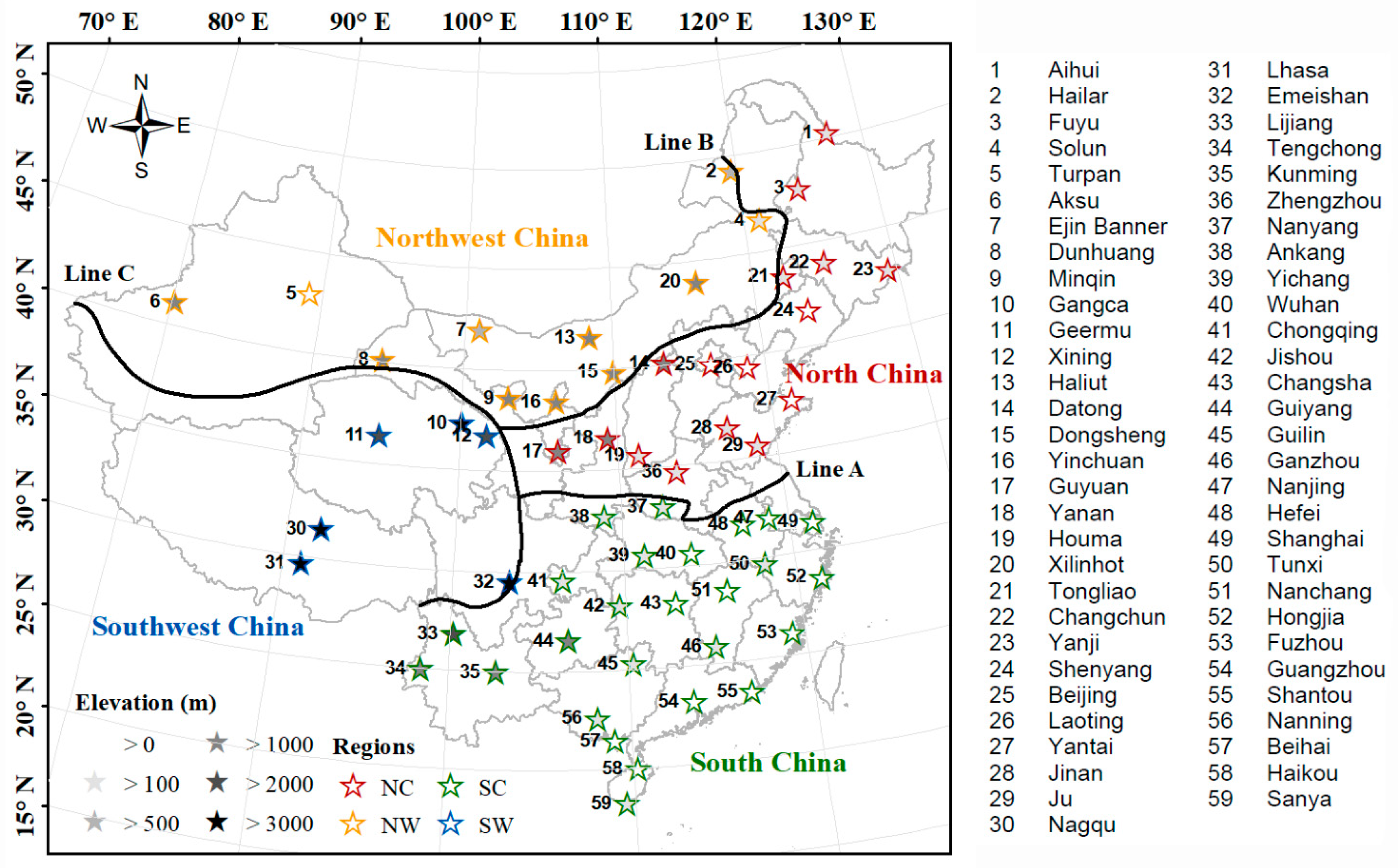
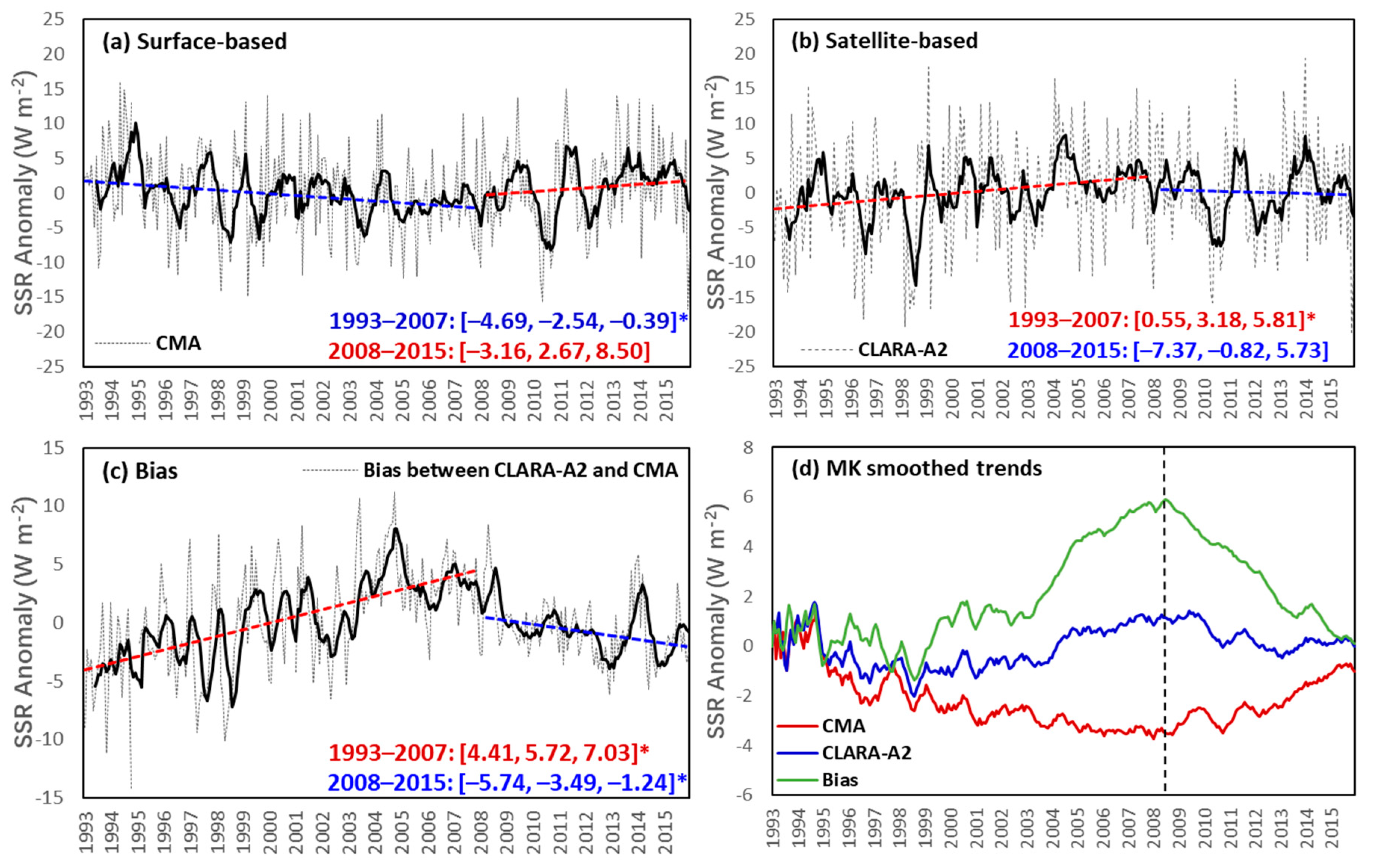
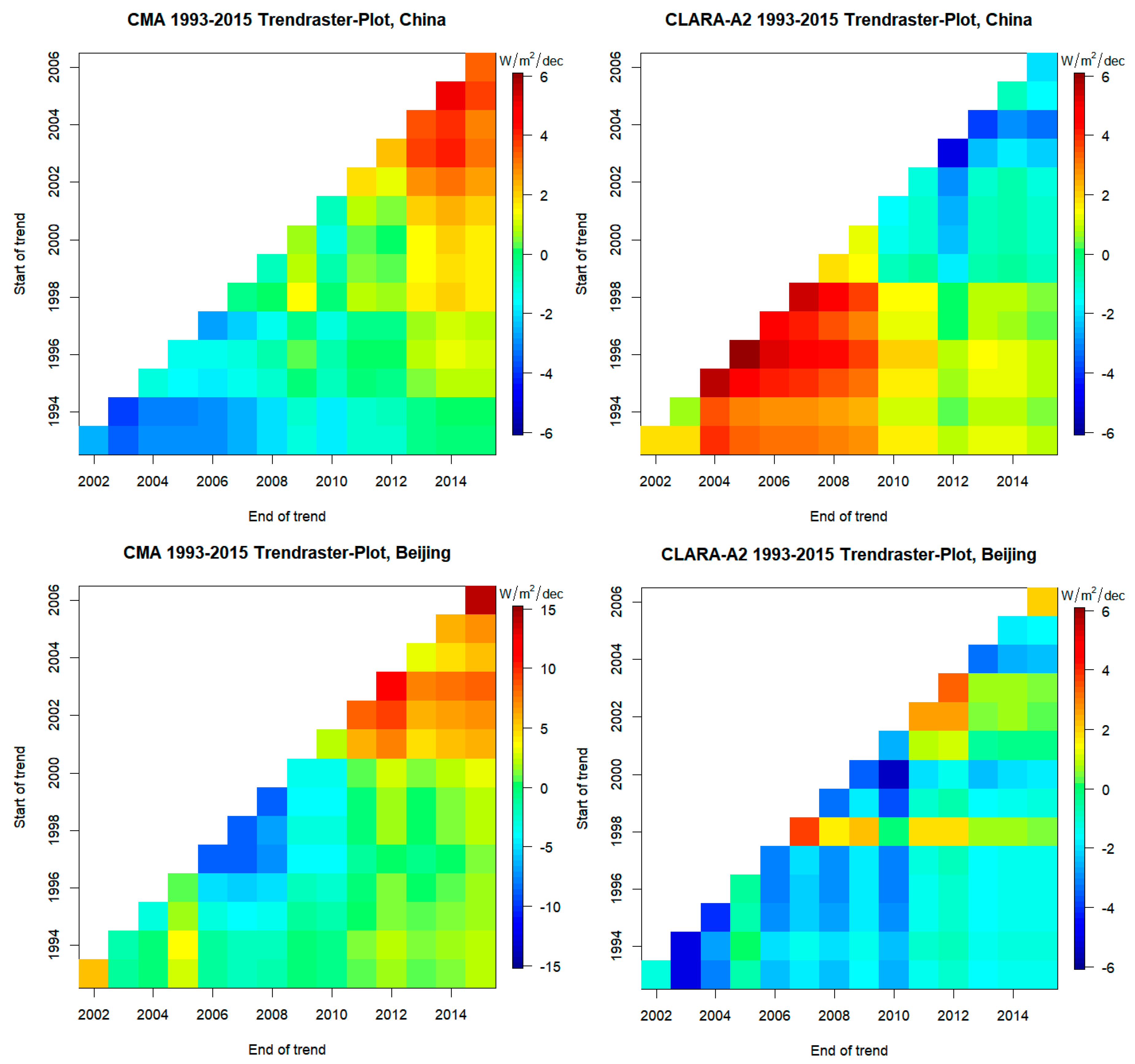
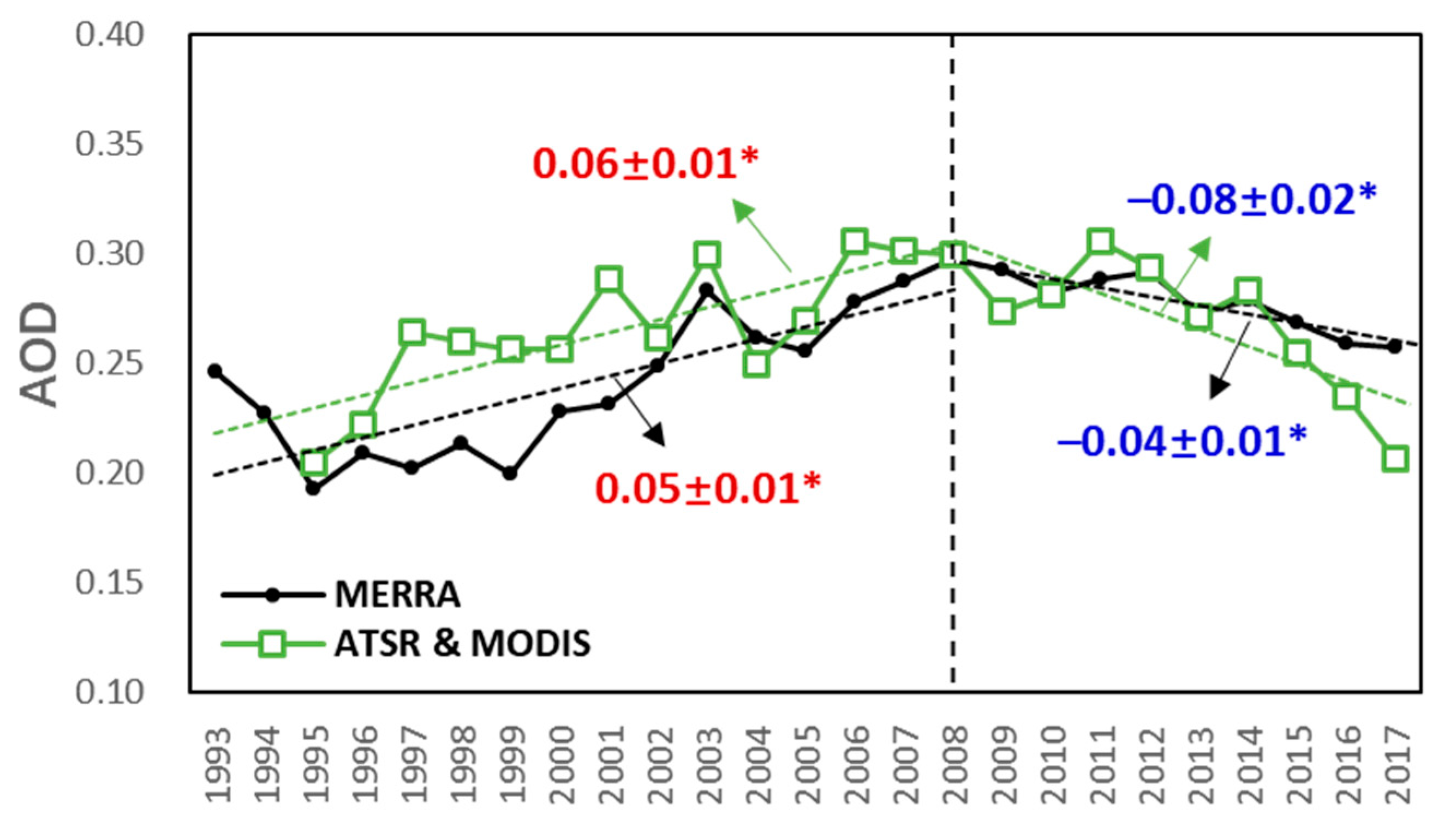
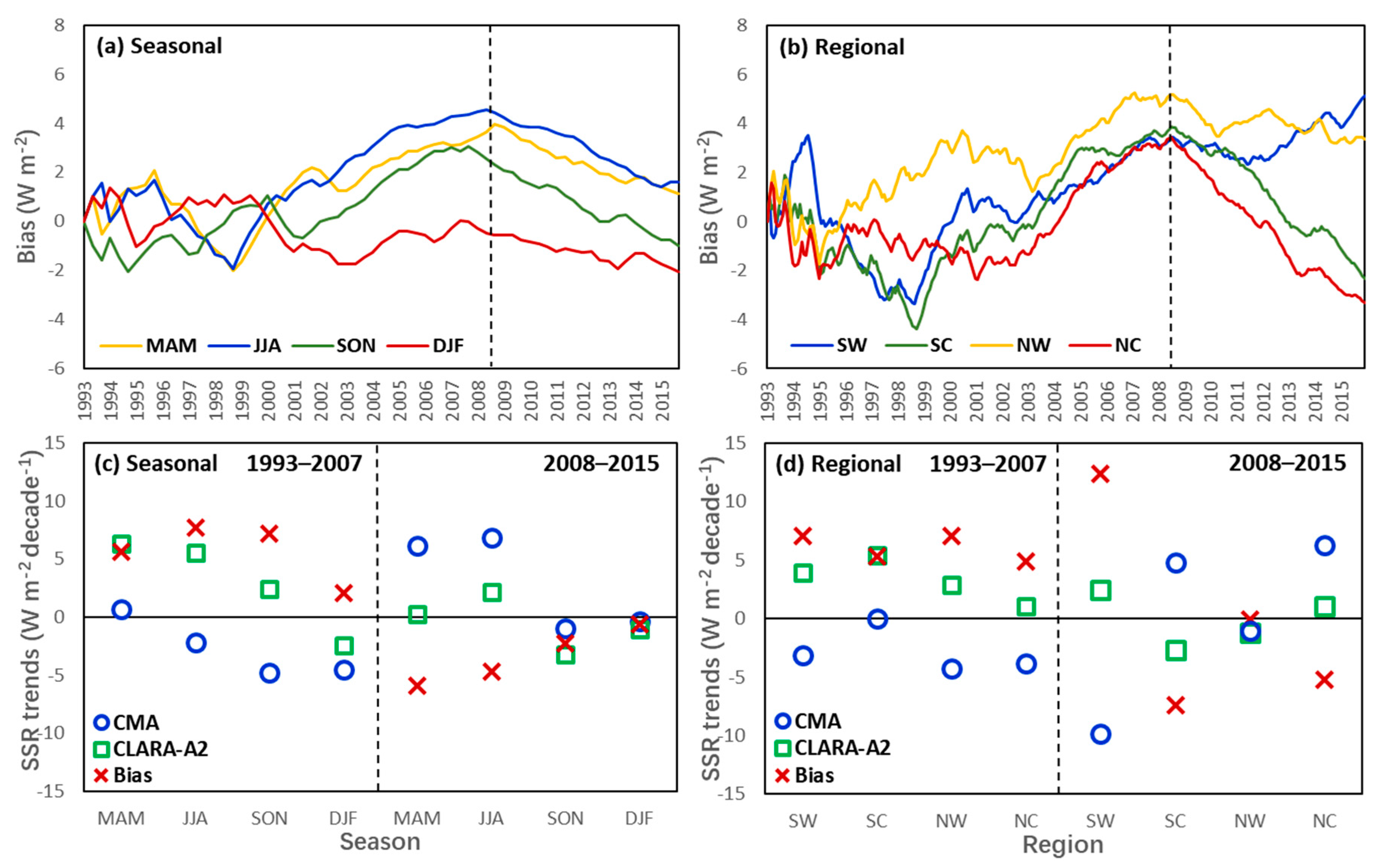
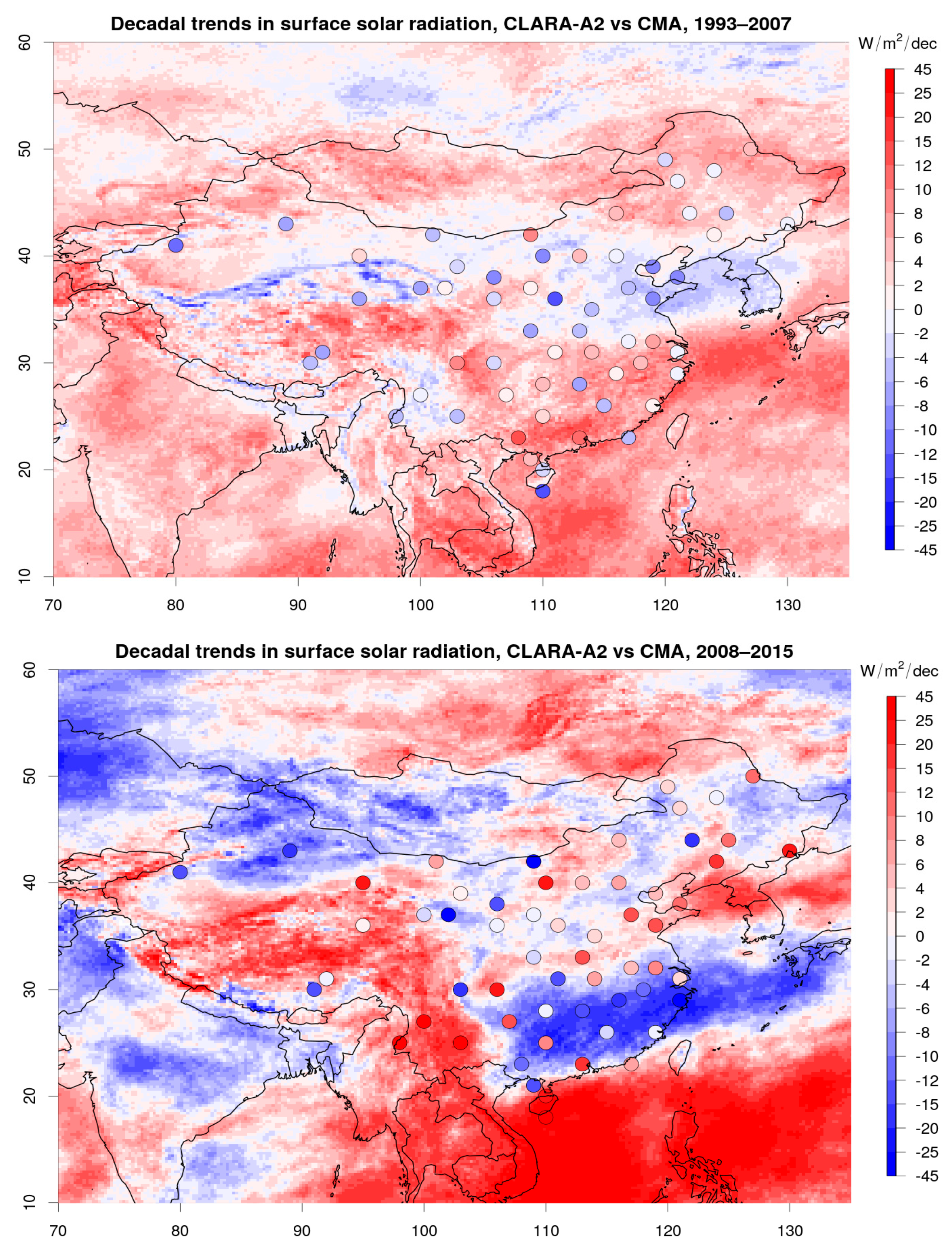
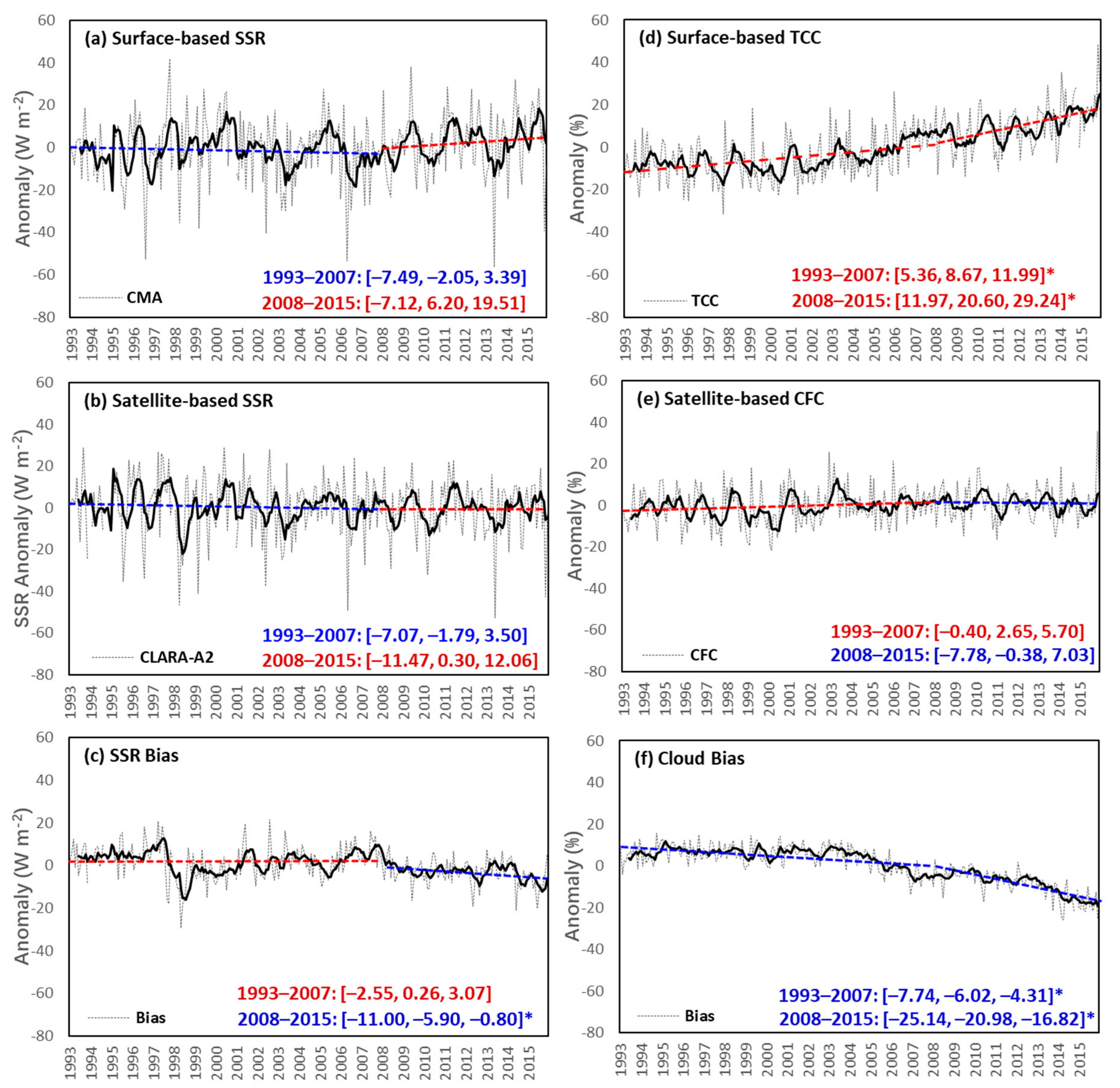


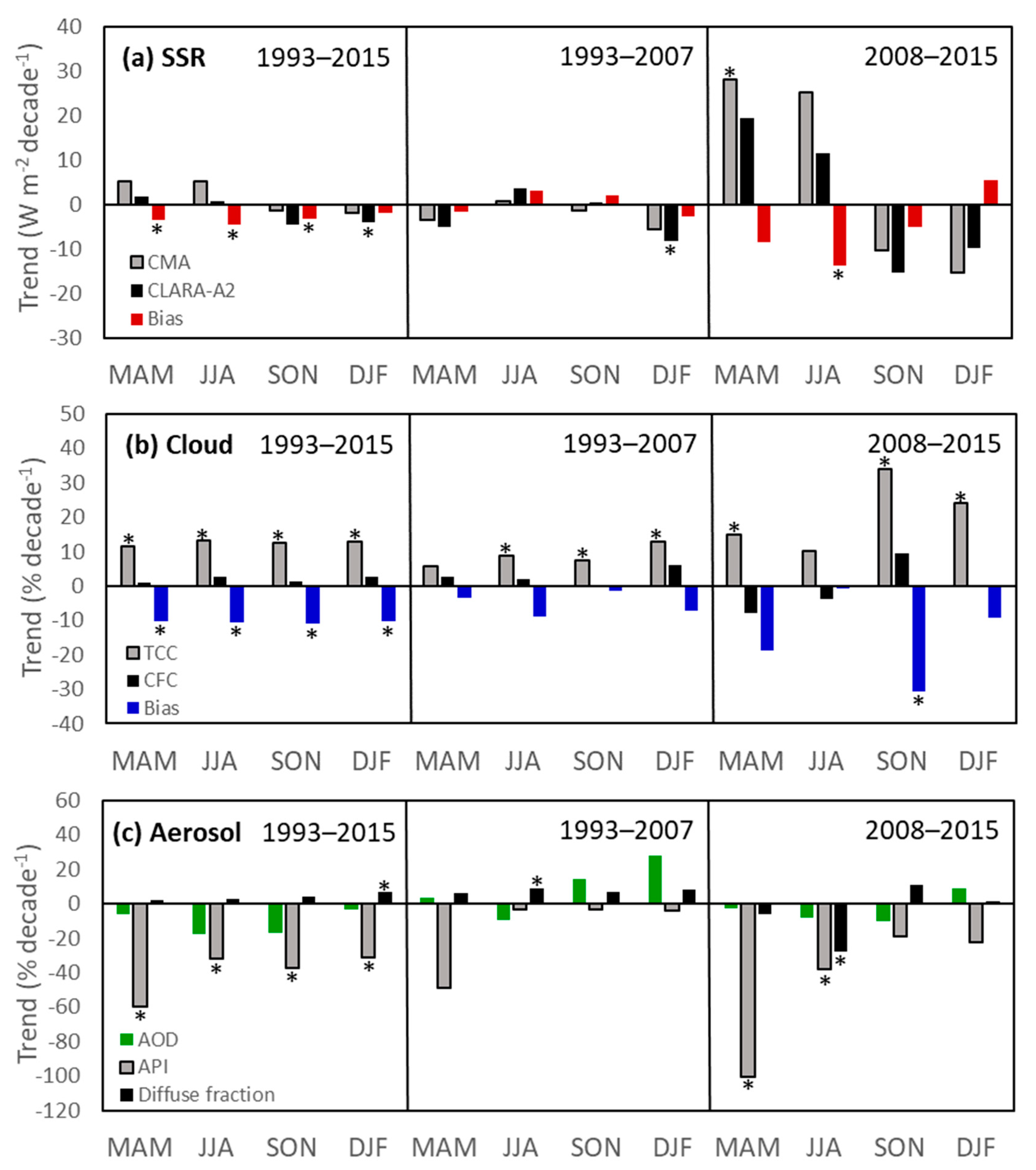
| SSR Bias vs. | Periods | Annual | Spring | Summer | Autumn | Winter |
|---|---|---|---|---|---|---|
| TCC | 1993–2015 | −0.12 * | −0.23 * | −0.13 | −0.18 | 0.06 |
| 1993–2007 | 0.09 | −0.09 | 0.23 * | 0.17 | 0.08 | |
| 2008–2015 | 0.08 | −0.05 | 0.21 | −0.16 | 0.49 * | |
| AOD | 2001–2015 | 0.47 * | 0.49 * | 0.47 * | 0.40 * | 0.61 * |
| 2001–2007 | 0.53 * | 0.69 * | 0.44 * | 0.34 | 0.57 * | |
| 2008–2015 | 0.40 * | 0.24 | 0.42 * | 0.38 * | 0.69 * | |
| API | 2001–2012 | 0.48 * | 0.48 * | 0.59 * | 0.54 * | 0.51 * |
| 2001–2007 | 0.24 * | 0.14 | 0.52 * | 0.25 | 0.56 * | |
| 2008–2012 | 0.43 * | 0.70 * | 0.08 | 0.30 | −0.12 |
© 2019 by the authors. Licensee MDPI, Basel, Switzerland. This article is an open access article distributed under the terms and conditions of the Creative Commons Attribution (CC BY) license (http://creativecommons.org/licenses/by/4.0/).
Share and Cite
Wang, Y.; Trentmann, J.; Pfeifroth, U.; Yuan, W.; Wild, M. Improvement of Air Pollution in China Inferred from Changes between Satellite-Based and Measured Surface Solar Radiation. Remote Sens. 2019, 11, 2910. https://doi.org/10.3390/rs11242910
Wang Y, Trentmann J, Pfeifroth U, Yuan W, Wild M. Improvement of Air Pollution in China Inferred from Changes between Satellite-Based and Measured Surface Solar Radiation. Remote Sensing. 2019; 11(24):2910. https://doi.org/10.3390/rs11242910
Chicago/Turabian StyleWang, Yawen, Jörg Trentmann, Uwe Pfeifroth, Wenping Yuan, and Martin Wild. 2019. "Improvement of Air Pollution in China Inferred from Changes between Satellite-Based and Measured Surface Solar Radiation" Remote Sensing 11, no. 24: 2910. https://doi.org/10.3390/rs11242910
APA StyleWang, Y., Trentmann, J., Pfeifroth, U., Yuan, W., & Wild, M. (2019). Improvement of Air Pollution in China Inferred from Changes between Satellite-Based and Measured Surface Solar Radiation. Remote Sensing, 11(24), 2910. https://doi.org/10.3390/rs11242910








